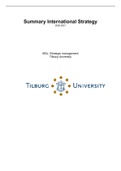Summary International Strategy
2020-2021
MSc. Strategic management
Tilburg University
,Lecture 1
Introduction to International strategy
We assume that the general objective of a strategy is to achieve a sustainable competitive
advantage leading to above-average economic performance. This usually involves building
upon firm-specific advantages such as core knowledge, competencies, efficiencies, and
business models.
With international strategy we match a multinational enterprise’s (MNE’s) internal strengths:
- With the opportunities and challenges found in cross-border environments
- While overcoming the disadvantages of being a foreign company
- And/or capitalizing on the advantages of being a foreign company
- And/or capitalizing on the advantages of having an international network
Elements of international strategy (Benito, 2015)
Why – internationalization motives
- Market seeking
- Efficiency seeking
- Resource seeking
- Strategic asset seeking
Where – location choice
- Attractiveness of country
- ‘’Distance’’ to home country
What – internationalization activities
- Marketing & sales
- Manufacturing
- Purchasing, extraction
- R&D
- …
How – internationalization type
- Export
- Licensing
- Franchising
- Joint Venture/ alliance
- Foreign Direct Investment (FDI)
- Brownfield scout available buildings
- Greenfield new venture from the ground up
Why
Issues Markets Efficiency Resources Strategic assets
Where Key location Size, Cost level, Resource Dynamic
factors purchasing infrastructure, availability, clusters, level of
power, level of proximity economic and development,
development, political stability urban centers
proximity
How Key Brands Specialized Supply security/ Pre-emptions of
internalization Consumer investments stability competition
factors goods, services Production of Primary sectors, High-tech
Typical sectors goods, back- vertical supply
and industries office services chains
What Exemplar Marketing and Manufacturing Extraction and Research and
activities sales Productivity, production development
Key Market share, cost margin, Input cost, Innovations,
performance volume sold, profitability supply patents, new
indicators sales growth reliability, price- product
cost margin instructions
,Foundations of international business strategy
1. Internationally transferable (or non-location bound) firm-specific advantages (FSAs)
2. Non-transferable (or location bound) FSAs
3. Location advantages
4. Investment in – and value creation through – resource recombination
5. Complementary resources of external resources
6. Bounded rationality
7. Bounded reliability
8. Advantages of foreignness: cultural attraction and arbitraging
1 & 2 FSAs (transferable and non-transferable)
The MNE’s unique resource base
- Physical resources
- Financial resources
- Human resources
- Upstream knowledge
- Downstream knowledge
- Administrative knowledge
- Reputational resources
Examples of transferable FSAs (non-location bound FSAs)
- Patents
- Money
- Machinery/technology
- Brand name
Examples of non-transferable FSAs (location bound FSAs)
- Location
- Network
- Brand name
Firm-specific advantages are very related to the core competencies of Prahalad and Hamel. A
firm is a portfolio of core competencies. It is the firm’s ability to bring together all of its resources
and capabilities to create a competitive advantage.
A core competence should:
1. Provide access to a wide variety of markets, and
2. Contribute significantly to the end-product benefits, and
3. Be difficult for competitors to imitate.
3 Location advantages
Location advantages are factors that make a particular location attractive
4 Recombination of capabilities
Recombination capabilities is the artful orchestration of resources, especially knowledge
bundles. In the international arena, recombination capabilities are built up through international
experience.
- Host-country specific experience
- General internationalization experience
, 5 Complementary resources of external actors
- Market knowledge/access
- Government connections
- Complementary technology
- …
Reason: cultural, economic, institutional and special ‘distance’.
(Meaning: missing success ingredients).
6 & 7 Liability of Foreignness (LoF)
A foreign firm has an a-priori disadvantage vis-à-vis a local firm, because of:
- Geographic, linguistic, economic, political, educational, institutional, cultural, and other
distances
- Bounded rationality ‘’scarcity of mind’’ – imperfect assessment of a present
or future state of affairs, thereby leading to incorrect beliefs.
- Bounded reliability ‘’scarcity of effort’’ – imperfect efforts towards pre-
specified goal achievement, thereby leading to incomplete fulfilment of
promises.
8 Advantages of foreignness: cultural attraction and arbitraging
A foreign firm may also have an a-priori advantage vis-à-vis a local firm, because of:
- Cultural attractiveness
- US fast food
- French wine
- The possibility of arbitraging between different regimes
- Cost of inputs
- Taxes
- Environmental and labor standards
International business strategy model
The shading of the middle of the
host country triangle emphasizes
the importance of developing new
LB FSAs in the host country. These
LB FSAs complement the FSAs the
firm has transferred from the home
country, and are critical to achieve
the firm’s goals, in terms of
accessing and benefiting from the
location advantages (LAs) of the
host country. If the firm commands
insufficient FSAs internally to access
and benefit from these LAs, it may
draw upon complementary
resources of external economic
actors to achieve its goals in the host
country.
Four types of MNEs
1. Centralized exporters
2. International projectors
3. International coordinators
4. Multi-centered MNEs







